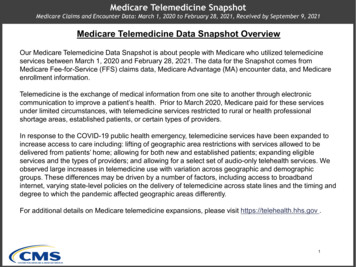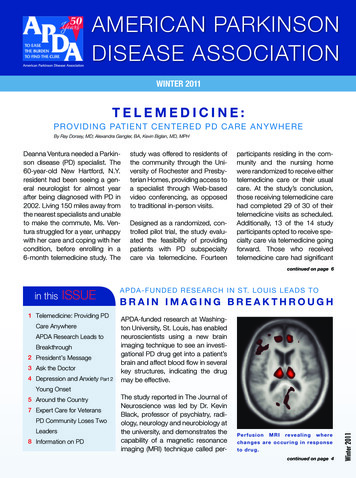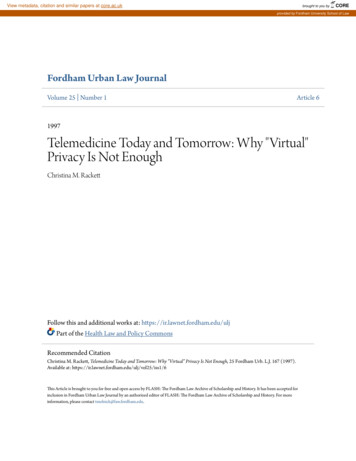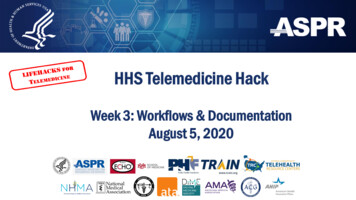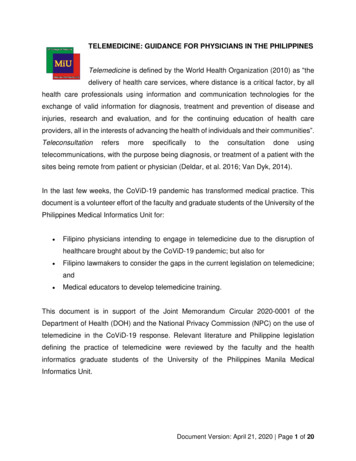
Transcription
TELEMEDICINE: GUIDANCE FOR PHYSICIANS IN THE PHILIPPINESTelemedicine is defined by the World Health Organization (2010) as “thedelivery of health care services, where distance is a critical factor, by allhealth care professionals using information and communication technologies for theexchange of valid information for diagnosis, treatment and prevention of disease andinjuries, research and evaluation, and for the continuing education of health careproviders, all in the interests of advancing the health of individuals and their llytotheconsultationdoneusingtelecommunications, with the purpose being diagnosis, or treatment of a patient with thesites being remote from patient or physician (Deldar, et al. 2016; Van Dyk, 2014).In the last few weeks, the CoViD-19 pandemic has transformed medical practice. Thisdocument is a volunteer effort of the faculty and graduate students of the University of thePhilippines Medical Informatics Unit for: Filipino physicians intending to engage in telemedicine due to the disruption ofhealthcare brought about by the CoViD-19 pandemic; but also for Filipino lawmakers to consider the gaps in the current legislation on telemedicine;and Medical educators to develop telemedicine training.This document is in support of the Joint Memorandum Circular 2020-0001 of theDepartment of Health (DOH) and the National Privacy Commission (NPC) on the use oftelemedicine in the CoViD-19 response. Relevant literature and Philippine legislationdefining the practice of telemedicine were reviewed by the faculty and the healthinformatics graduate students of the University of the Philippines Manila MedicalInformatics Unit.Document Version: April 21, 2020 Page 1 of 20
This guidance seeks to answer the following questions: Who can practice telemedicine?Any physician with a valid license from the Philippine Professional RegulationCommission (PRC) can engage in telemedicine with patients physically residingin the Philippines. What are the minimum competencies to practice telemedicine?Telemedicine requires proficiency in digital communication skills, clinical acumenand knowledge of technology and equipment to be used, while adhering toethical practice. What are the minimum requirements to set up for telemedicine?A communication device such as a landline phone, cellphone with or withoutcamera, and/or computer will be required. If using video or chat software, a stableinternet connection is vital. A private, well-lit location is preferred, especially forvideo consult.AUTHORSIris Thiele Isip Tan MD, MScChief, UP Medical Informatics UnitUP College of MedicineAlvin Marcelo MDFaculty, UP Medical Informatics UnitUP College of MedicineFrancis Sarmiento III MDMS Health Informatics student,UP College of MedicineLisa Traboco MDMS Health Informatics student,UP College of MedicineMichael Fong MDMS Health Informatics student,UP College of MedicineRoy Dahildahil RMTMS Health Informatics student,UP College of MedicineAngelica Guzman MDMS Health Informatics student,UP College of MedicineNelson Tiongson RN, MScMS Health Informatics Alumnus,UP College of MedicineJan Michael Herber RNMS Health Informatics student,UP College of MedicineMillicent Ong MD, MScMS Health Informatics AlumnaUP College of MedicineFor questions and comments, please contact Dr. Isip Tan at icisiptan@up.edu.ph.Date released: 21 April 2020Document Version: April 21, 2020 Page 2 of 20
Who can practice telemedicine?Any physician with a valid license from the Philippine Professional RegulationCommission can engage in telemedicine with patients physically residing in thePhilippines.The Medical Act of 1959 in Section 10 (a), defines the practice of medicine thus,“physically examine any person, and diagnose, treat, operate or prescribe any remedyfor human disease, injury, deformity, physical, mental, psychical condition or any ailment,real or imaginary.” Since physically examining patients appears required of the law, itmight preclude the practice of telemedicine until this law is revised. The DOH-NPC jointcircular memorandum has recognized that licensed physicians may engage intelemedicine despite absence of physical contact but states that, “the gold standard forclinical care remains to be face-to-face consultation.”Section 10b of the Medical Act of 1959 provides that a person engaged in the practice ofmedicine, “who shall by means of signs, cards, advertisements, written or printed matteror through the radio, television or any other means of communication, either offer orundertake by any means or method to diagnose, treat, operate or prescribe any remedyfor any human disease, injury, deformity, physical, mental or psychological condition.”Written before the advent of telemedicine, it indicates “any other means ofcommunication” and “any means or method to diagnose, treat, operate or prescribe anyremedy” which can perhaps be loosely applied in the context of telemedicine. In itsdefinition of terms, the DOH-NPC joint issuance defined telemedicine as “the practice ofmedicine by means of electronic and communications technologies such as phone call,chat or short messaging service (SMS), audio- and video-conferencing to deliverhealthcare at a distance between a patient at an originating site, and a physician at adistant site.”It is worthwhile to note that the Medical Act of 1959 also mentions an exemption to thepractice of medicine, i.e., “any person who renders any service gratuitously in cases ofemergency, or in place where the services of a duly registered physician, nurse or midwifeare not available.” Taking note of “gratuitously,” such exemption likely applies due to theCoViD-19 pandemic and the community quarantine, when the shortage of healthprofessionals is felt even more acutely.In the light of a lack of national legislation along with rules and regulations specific for thepractice of medicine utilizing telemedicine by both Filipino and foreign licensed physicianscatering to patients residing in the Philippines at the time of the telemedicine encounter,Document Version: April 21, 2020 Page 3 of 20
it can be surmised that only Filipino licensed physicians can practice telemedicine forpatients residing in the Philippines.On the other hand, Filipino licensed physicians may practice telemedicine beyondnational jurisdictional borders subject to applicable laws and regulations of the country ofresidence of the telemedicine patient-client. In addition, overseas-based Filipino licensedphysicians may continue to cater to Philippine-based patients, regardless of otherlicenses that they possess, provided that they have retained their Philippine citizenshipto similarly retain their PRC licenses. Otherwise, conditions and requirements set by thePRC for non-Filipino licensed physicians practicing in the Philippines shall apply.In past years, legislation has been sought to define the practice of telemedicine. Proposedcongressional bills include House Bill (HB) No. 6366 (The Telehealth Act of 2012), HBNo. 4199 (Telehealth Act of 2014), and more recently, Senate Bill (SB) No. 1618 (ThePhilippine eHealth Systems and Services Act).Section 11 of SB 1618 states that telehealth and telemedicine services, “shall not beunderstood to modify the scope of medical practice or any health care provider orauthorize the delivery of health care service in a setting or manner not otherwiseauthorized by the law.” This is similarly stated in Section 16 of HB 4199, that“ the standardof care is the same as regardless whether a health care provider provides health careservices in person or by telemedicine.”As stated in Section 5 of HB 6336, “the DOH and the Philippine Health InsuranceCorporation (PHIC) shall require telehealth practitioners in both originating and distantsites to undergo accreditation, through the National Telehealth Reference Center.”Section 8 of the same bill sought to establish a National Telehealth Board to “establishtelehealth guidelines and regulations pertinent to its practice and provision of service.” Asimilar body, the National eHealth Steering Committee, is provided for by Section 8 of SB1618. Among its functions is to “create or identify the telehealth licensing and regulatorymechanisms and body to implement these.” In contrast to HB 6336, SB 1618 tasks theProfessional Regulation Commission to be the lead agency in accrediting telehealthpractitioners with PHIC accreditation for reimbursement purposes only.Section 10 of HB 4199 clearly enumerates who may practice telehealth: “a registeredmedical practitioner holding a valid Philippine license; or health care provider or licensedindividual who provides health care within the scope of his/her professional license.” Thesame section further states that, “a telehealth care provider must be registered with theDOH through a procedure established by it.”Document Version: April 21, 2020 Page 4 of 20
Such an accreditation or registration process for physicians who wish to engage intelemedicine is currently not in place and should be planned for in the post-pandemicscenario. With the current gaps in legislation, only physicians licensed by the ProfessionalRegulation Commission can engage in telemedicine with patients physically residing inthe Philippines.Document Version: April 21, 2020 Page 5 of 20
What are the minimum competencies to practice telemedicine?Telemedicine requires competency in the following areas: digital communication skills,clinical acumen, and knowledge of technology and equipment to be used, while adheringto ethical practice.The Commission on Higher Education (CHED) Memorandum Order 18, series of 2016,defined the program outcomes for the Doctor of Medicine program. While telemedicinewas not specifically mentioned, Article V Section 6.3 includes medical informatics underits minimum curricular content. Pathipati, et al. (2016) argue that although youngerphysicians are digital natives and therefore comfortable with technology, this does notnecessarily assure high-quality telemedical care. They recommend that telemedicaltraining be incorporated in the medical curriculum. Pourmand, et. al., (2020) found thatinclusion of telemedicine in medical school curricula in the US has plateaued in recentyears, likely due to the curricula already being full. Waseh & Dicker (2019) suggesttelemedicine competencies be combined with existing medical curriculum components,such as rural care exposure and inter-professional training, instead of carving out aseparate course.Demiris (2003) also recommended incorporation of telemedicine in graduate medicalinformatics education, noting that keeping course content updated will be challenginggiven the rapid advances in technology.Van Houwelingen, et al. (2016) identified competencies required for nursing telehealthactivities. While some were already present in nursing education, they found newcompetencies specifically linked to telehealth activities. This has implications in trainingfor physicians too, where requisite skill sets may be dictated by specific telemedicinescenarios or applications. Chaet, et al., (2017) discussed this as well by recommendingthat physicians also be proficient and comfortable in the use of telemedicine-associatedavailable technology, including awareness of its limitations of when to shift to face-to-faceconsultation. Differences should be addressed by training of users with regular workshopsor with guidance from their corresponding ICT departments. As an example, Jagolino etal. (2016) have recommended competency milestones for telestroke training in vascularneurology fellowship.To list competencies for telemedicine, a PubMed search was conducted using the MesHterms, “telemedicine,” AND “clinical competence” OR “competency-based education”;("Education, Medical"[MeSH] OR "Education, Medical, Undergraduate"[Mesh] OR"Education, Medical, Graduate"[MeSH] OR "Education, Medical, Continuing"[MeSH])AND "Telemedicine"[MeSH]. Pertinent results are discussed as follows.Document Version: April 21, 2020 Page 6 of 20
Sapci & Sapci (2019) recommended skills training for telemedicine for nursing students.Their proposed learning outcomes can also apply to physicians:1. Knowledge and attitudea. Demonstrate knowledge of the operation of telemedicine and patientmonitoring technologiesb. Identify how technology can be used in sharing information with colleaguesc. Formulate how telemedicine can be deployed in existing pathwaysd. Demonstrate how to collect health-related data for patient monitoringe. Validate the potential benefits of telehealthf. Present confidence that technology is not difficult to useg. Demonstrate open-mindedness to innovations in ICT and motivationalattitude2. Technological skillsa. Demonstrate skills to train the patient to use the equipmentb. Formulate skills to manage telemedicine data sets, software packagesand toolsc. Apply skills to check equipment for functionalityRecognizing that a face-to-face care health encounter can be very different from ateleconsultation, Sharma, et al., (2019) proposed the following core competencies:1. Digital communication and webside mannera. Optimal visualization, body language and speech (communication speed,colloquial speech, body motion and gestures), dress, camera, background,lighting and framingb. Graphic-assisted communication: imaging and diagnostic findingsc. Virtual technologies: understand and troubleshoot platforms2. Scope and standards of carea. Licensing: state-specific licensing requirementsb. Billing and insurance: coverage for virtual visitsc. HIPAA (Health Insurance Portability and Accountability Act) compliance:privacyd. Prescribing: legal limits of e-prescribinge. Virtual care pathways: appropriate follow-up and emergent responseDocument Version: April 21, 2020 Page 7 of 20
3. Virtual clinical interactionsa. Environmental assessment: safety, cleanliness, activities of daily livingb. Virtual physical exam: remote exam techniques, remote monitoring devicesc. Group interactions: management of family and group dynamicsPicot (2000) identified the types of training needed according to different applications thatmay be used:1. Videoconferencing: equipment selection, medicolegal issues, ergonomic roomdesign, recording media and storage2. Remote telemedicine: troubleshooting, medicolegal issues, physician assistantskills, patient care, technical assessment, knowledge of a wide range oftechnologies, basics of imaging technologies3. Health information structures: privacy legislation, security and confidentiality,information and database management, knowledge of computer and networktechnologies4. Tele-imaging: image capture and transfer, network capacity, software interfaces,picture archiving and communication systems management, imaging standards,storage and transfer over networks5. Home telecare: telemonitoring device troubleshooting and installation, patienteducation skills, medicolegal issues, knowledge of teletriageEven using just the telephone for telemedicine requires some skills. According to Car &Sheikh (2003) the following should be the focus of training in telephone consultationskills: Active listening and detailed history taking Frequent clarifying and paraphrasing (to ensure that messages have beenreceived in both directions) Picking up cues (such as pace, pauses, change in voice intonation) Offering opportunities to ask questions Offering patient education and documentation.Ethical use of telemedicine is also a core competency. Rienits, et al., (2016) developed alesson on telehealth consultation skills with interactive stations. They found that medicalstudents valued learning at the ethics station the most. The questions asked at this stationare also relevant locally and need to be discussed: Why is recording of the interview not encouraged? Can a patient with psychosis give informed consent to a teleconsultation? What could you do if the teleconnection fails? What could you do if your indigenous patient refuses to be filmed?Document Version: April 21, 2020 Page 8 of 20
Physicians must respect ethical principles when practicing telemedicine. The WorldMedical Association (2018) highlighted the following guidelines: maintain mutual trust andrespect between the patient and physician; ensure confidentiality, privacy, and dataintegrity; obtain proper informed consent (Appendix A - Sample Patient Consent Form);value autonomy and privacy of the physician; perform basic responsibilities of a physician;and ensure quality of care rendered.Document Version: April 21, 2020 Page 9 of 20
What are the minimum requirements to set up for telemedicine?At the minimum, a communication device such as a landline phone, cellphone with orwithout camera, and/or computer will be required. If using video or chat software, a stableinternet connection is vital. A private, well-lit location is preferred, especially for videoconsult.HardwareIn low resource settings, there have been telemedicine services using only landline phonecalls, cellphone messages or SMS (Okoroafor, et al., 2017; Delgoshaei, et al., 2017).Text-based functions could be classified under synchronous type of teleconsultation.However, recommendations from the American Telemedicine Association, NationalHealth Services (UK), and the Office of the National Coordinator for Health InformationTechnology (ONC), include use of imaging peripherals.To look for camera resolutions that could be applicable, a PubMed Search was doneusing the following terms “Telemedicine” AND “megapixels” OR “pixels” OR “camera”.Another PubMed Search also looked into different subspecialties with focus on visualdiagnosis such as “Teledermoscopy” OR “Teleophthalmology”.In a teledermoscopy study done by Barcui & Lima (2018), a cellphone camera with 8megapixels would allow a match rate of 90% as compared to face-to-face diagnosis.While a teleophthalmology study in rural Brazil by Riberio, et al., (2014) showed an 85%accuracy using a cellphone camera with 5 megapixels.SoftwareWith the increasing use of smartphones, people have used these not only for personalmatters but also to communicate with their physicians especially during the pandemic.Aside from Facebook and Messenger, the Play Store (Android) and the App Store (iOS)charts for Social Communication have currently these top three instant messaging appsnamely, Viber, WhatsApp, and Telegram. A comparative study (Table 1) among these interms of security of communication recommended the use of Telegram over the two forits capability of synchronization, fast service, reliable backup, and better security feature(Sutikno, et al., 2016).Document Version: April 21, 2020 Page 10 of 20
Table 1. Whatsapp, Viber and Telegram in assessing the securitySecurity Is communication encrypted in transit (all usercommunications are encrypted along all the linksin the communication path)? Is communication encrypted with a key theprovider does not have access to (all usercommunications are end-to-end encrypted)? - Can correspondent’s identity be independentlyverified? -- Are past communications secured if keys arestolen? -- Is the code open to independent review?-- Is the crypto design well-documented? Has there been an independent security audit? Note: Table from “WhatsApp, Viber and Telegram which is Best for Instant Messaging?”, by Sutikno, T., Handayani, L., Stiawan, D., and Riyadi, M. A.,2016, International Journal of Electrical and Computer Engineering (IJECE), Volume 6, p. 913.Deepak et al. (2020) also noted that WhatsApp can serve as an interface betweendermatologists and patients during these times because it can deliver both real time videoconsultation and store and forward service with end-to-end encryption.Some countries, such as the US, have relaxed regulations during the CoViD-19 crisis toallow the use of applications such as FaceTime, Facebook Messenger, Hangouts, Zoomand/or Skype (HHS.Gov, 2020).Additionally, the following has been listed to be HIPAA-compliant video communicationproducts by their vendors and as such, these vendors will enter into an HIPAA businessassociate agreement (BAA) for these products (HHS.Gov, 2020). Skype for Business / Microsoft TeamsUpdoxVSeeZoom for HealthcareDoxy.meGoogle G Suite Hangouts MeetCisco Webex Meetings / Webex TeamsAmazon ChimeGoToMeetingSpruce Health Care MessengerDocument Version: April 21, 2020 Page 11 of 20
Note: The HIPAA BAA offered by these vendors have not been reviewed by the US Officeof Civil Rights. Moreover, this list does not constitute an endorsement, certification, orrecommendation of specific technology, software, applications, or products. There maybe other technology vendors that offer HIPAA-compliant video communication productsthat will enter into a HIPAA BAA with a covered entity. Further, this does not meanendorsement of any of the applications that allow for video chats listed above.Healthcare providers should inform patients that these may still have potential privacyrisks. “Public-facing” apps such as Facebook Live, Twitch or Tiktok should not be used toprovide telemedicine care.The American Medical Association Telemedicine (2020) Playbook suggested that whenselecting a telemedicine software or vendor, the provider should evaluate them accordingto security, usability, and customer service. A live demonstration, case reports and wordof-mouth referrals would help the provider select a software that is in alignment with theirspecific goals to pursue telemedicine.Google has made available a vendor security assessment questionnaire (VSAQ) to helpclients evaluate the readiness to provide secure systems. The questionnaire is availableat vsaq-demo.withgoogle.com . Doctors are advised to require potential vendors to fill upthe VSAQ, attest, and attach it in the contract.Internet ConnectionIn order to meet the demand for clear audio and video needed for telemedicine consults,the following minimum bandwidth speeds are recommended by the Office of the NationalCoordinator for Health Information Technology (ONCHIT accessible at HealthIT.gov) withsome modifications for the Philippine setting based on estimations from Search UnifiedCommunications. In principle, the number of simultaneous users matter. A minimum of 2Mbps per user is recommended for a resolution of HD720p and a frame rate of 30fps.Below is a summary table for recommended minimum bandwidth speeds per type ofhealth care provider.Document Version: April 21, 2020 Page 12 of 20
Table 2. Recommended minimum bandwidth speeds for different types of health c /LargePhysicianPracticeHospitalAcademic /LargeMedicalCenter11 to 32 to 455 to 25up to 50up to 5002 Mbps2 to 6 Mbps4 to 8 Mbps10 Mbps10 to 50Mbps100 Mbps1000 MbpsSupports practice/clinic/hospitalmanagement functions, email, andweb browsingYESYESYESYESYESYESYESAllows for concurrent use of highquality video consultations and EHR 1or EMR2, if anyYESYES(includingCHITS3)YESYESYESYESYESCapable of real-time image transferNONONONOYESYESYESPossible use of HD videoconsultationsYESYESYESYESYESYESYESEnables non-continuous remotemonitoringYESYESYESYESYESYESYESNumber of PhysiciansInternet Bandwidth Requirement1Electronic Health Record (EHR); 2 Electronic Medical Record (EMR); 3 Community Health Information Tracking System (CHITS)Note: Table adapted from from “What is the recommended bandwidth for different types of health care providers?” by Office of the NationalCoordinator for Health Information Technology and “How to calculate video conferencing bandwidth requirements” by Lazar, I, Search UnifiedCommunications.It must be noted that estimating bandwidth requirements can be affected not just bynumber of concurrent users or devices, but also location, real-time transactions,hardware, storage technology. In order to estimate the speed and quality of the internetconnection, one may use internet speed testing sites, such as https://www.speedtest.net/.Office Space & LightingGreenhalgh (2020) advises a private, quiet, and well-lit room to be used in telemedicineconsultation. Rheuban (2018) from the American Medical Association, advises seatsdesigned for a comfortable interaction and the platform table for the computer secure toavoid wobbling. The camera should be at eye level. Krupinski (2014) further elaboratesto recommend planning the layout of the office space with respect to ventilation, airconditioner or heating, and any equipment that will be used must be within easy reachingdistance from the seat. For lighting, they also recommend the use of white light,fluorescent day-light or full crescent bulb instead of incandescent. While most practiceswill likely be home-based, a single-color background would be recommended, such aslight-blue, and clutter should be avoided. This is so that both participants can focuswithout distraction. The audio can also “make or break” the conversation. Echo can beeliminated in carpeted rooms (Major, 2005)Document Version: April 21, 2020 Page 13 of 20
Attire & DecorumPart of professionalism is to wear appropriate attire. This also applies even if working fromhome. Petrilli, et al., (2015) previously observed that older patients prefer physicianswearing formal attire and white coats. However, according to Demiris, et al. (2010) lightcolors and white coats can increase reflection and glare on digital screens. While variousnoisy patterns and bright colors can look good on some people, it may not translate wellto screen monitors (Wade, 2018; Whitzman, 2016).What physicians do in front of the camera is also important, as angle or vantage pointmight emphasize bad posture or habits such as fidgeting. Simple actions such as turningaway to write notes can make one disappear from the view of the patient. If there is apicture-in-picture feature, disable this setting. Look at the patient. Wearing headsets mayensure additional privacy, but if the area is secluded, focus should be made in projectinga natural environment (Gonzales, 2017).Document Version: April 21, 2020 Page 14 of 20
REFERENCES:1. American Medical Association. (2020, April 20). How health system leaders arenavigating the CoViD-19 crisis. Retrieved April 20, 2020 from https://www.amaassn.org2. American Telemedicine Association. (2014, May). Core Operational Guidelinesfor Telehealth Services Involving Provider-Patient Interactions (An Update of theFebruary 2008 “Core Standards for Telemedicine Operations”); May 20143. Barcaui, C., & Lima, P. (2018). Application of Teledermoscopy in the diagnosis ofPigmented Lesions. International Journal of Telemedicine and Applications.doi:10.1155/2018/16240734. Car, J., & Sheikh, A. (2003). Telephone consultation. BMJ, 966-9.doi:10.1136/bmj.326.7396.9665. Chaet, D., Clearfield, R., Sabin, J., & Skimming, K. (2017). Ethical practice inTelehealth and Telemdicine. J Gen Intern Med, 1136-1140. doi:10.1007/s11606017-4082-26. Deldar, K., Bahaadinbeigy, K., & Tara, S. (2016). Teleconsultation and ClinicalDecision Making: a Systematic Review. ACTA INFORM MED., 24(4): 286-292.doi:10.5455/aim.2016.24.286-2927. Delgoshaei, B., Mobinizadeh, M., Mojdekar, R., Afzal, E., Arabloo, J., &Mohamadi, E. (2017). Telemedicine: A systematic review of economicevaluations. Med J Islam Repub Iran. doi:10.14196/mjiri.31.1138. Demiris, G. (2003). Integration of Telemedicine in Graduate Medical InformaticsEducation. J Am Med Inform Assoc, 310-314. doi:10.1197/jamia.M12809. Demiris, G., Charness, N., Krupinski, E., Ben-Arieh, D., Washington, K., Wu, J.,& Farberow, B. (2010). The role of human factors in telehealth. Telemed J EHealth, 446-53. doi:10.1089/tmj.2009.011410. Department of Health. (2020, April 7). Department of Health MemorandumCircular No. 2020-0016. From Department of health-update/mc2020-0016.pdf11. Department of Health, National Privacy Commission; Guidelines for the use ofTelemedicine in CoViD19 Response; (March 28, alth-update/mc2020-0016.pdf12. Gonzales, R. (2017, October 26). Telemedicine Is Forcing Doctors to Learn'Webside' Manner. Retrieved April 20, 2020 from forcing-doctors-to-learn-websidemanner/13. Greenhalgh, T., Shaw, S., Seuren, L., & Wherton, J. (2020). Video consultationinformation for GPs. Oxford: University of Oxford.Document Version: April 21, 2020 Page 15 of 20
14. House Bill No 6336, An Act Promulgating a Comprehensive Policy For A NationalSystem For Telehealth Service in the Philippines. Fifteenth Congress, SecondSession (2012)15. House Bill No. 4199, The Telehealth Act of 2014. Sixteenth Congress, FirstSession (2014)16. HHS.Gov. (2020, April 18). Notification of Enforcement Discretion for Telehealth.From US Department of Health & Human on-enforcement-discretion-telehealth/index.html17. Jagolino, A., Jia, J., Gildersleeve, K., Ankrom, C., Cai, C., Rahbar, M., . . . Wu, T.(2016). A call for formal telemedicine training during stroke fellowship. AmericanAcademy of Neurology, 182701833. doi:10.1212/WNL.000000000000256818. Jakhar, D., Kaul, S., & Kaur, I. (2020). WhatsApp messenger as ateledermatology tool during coronavirus disease (CoViD-19): From Bedside toPhone-side. doi:10.1111/CED.1422719. Krupinski, E. (2014). Telemedicine Workplace Environments: Designing forSuccess. Healthcare (Basel), 115-122. doi:10.3390/healthcare201011520. HealthIT.gov. (2019, September 10). What is the recommended bandwidth fordifferent types of health care providers?. Retrieved April 20, 2020, providers21. Lazar, I. (2016). How to calculate video conferenc
UP College of Medicine Alvin Marcelo MD Faculty, UP Medical Informatics Unit UP College of Medicine Francis Sarmiento III MD . (2016) identified competencies required for nursing telehealth activities. While some were already present in nursing education, they found new competencies specifically linked to telehealth activities. This has .
